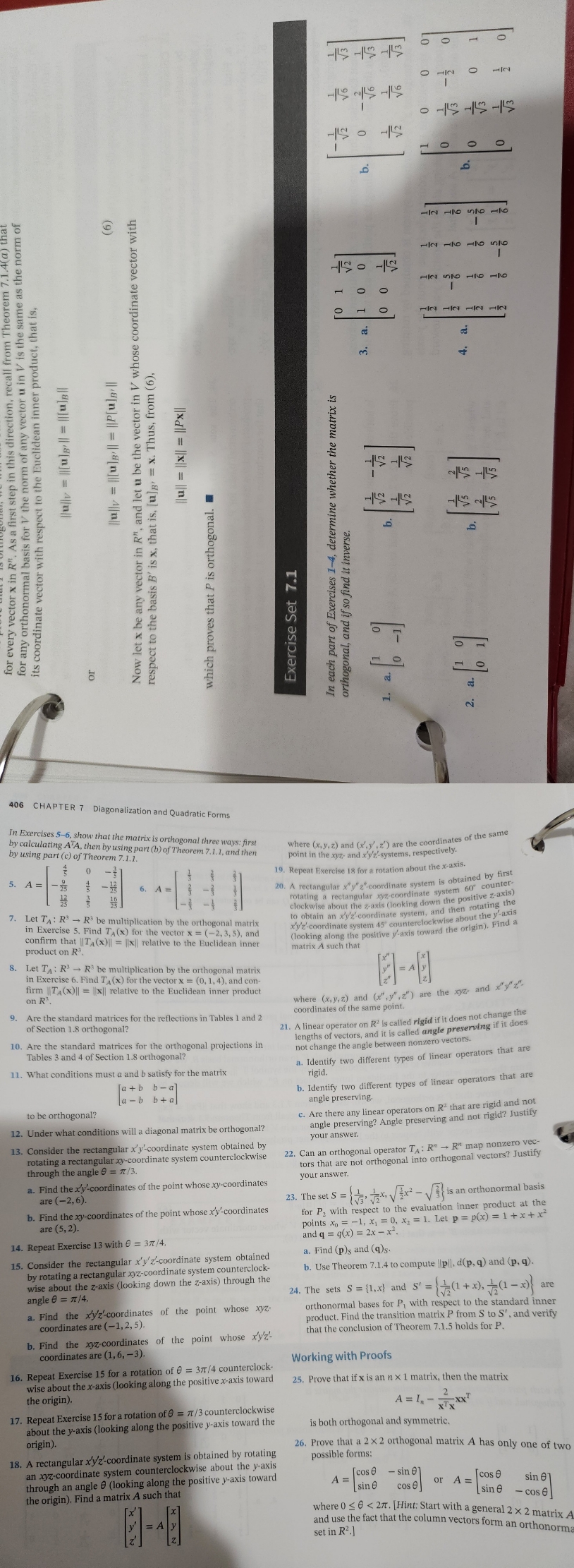Chapter 7.1 Write on paper for upvote. questions: 1, 3 , 5, 11, 12, 26 please
-145 -1455 - 1450 H O O HIN O HIN -NO InNo -No (6) HIN #ND HID Into O O a. for every vector x in R". As a first step in this direction, recall from Theorem 7.1.4(a) that for any orthonormal basis for V the norm of any vector u in V is the same as the norm of lully = ll[u]g'll = [u]Bll Now let x be any vector in R", and let u be the vector in V whose coordinate vector with lully = [u]B'll = (P[ulBill lull = 1/x/1 = UPx]I its coordinate vector with respect to the Euclidean inner product, that is, respect to the basis B' is x, that is, [u]g, = x. Thus, from (6), In each part of Exercises 1-4, determine whether the matrix is which proves that P is orthogonal. orthogonal, and if so find it inverse. Exercise Set 7.1 1. 2 10 -1 406 CHAPTER 7 Diagonalization and Quadratic Forms In Exercises 5-6, show that the matrix is orthogonal three ways: first by calculating A'A, then by using part (b) of Theorem 7.1.1, and then by using part (c) of Theorem 7.1.1. where (x, y. z) and (x.y' . 2') are the coordinates of the same point in the xyz- and x'y'z-systems, respectively. 19. Repeat Exercise 18 for a rotation about the x-axis. 20. A rectangular x"y"2"- coordinate system is obtained by first rotating a rectangular xyz-coordinate system 60" counter- 7. Let TA : R3 - R3 be multiplication by the orthogonal matrix clockwise about the z-axis (looking down the positive z-axis) to obtain an x'y'2-coordinate system, and then rotating the in Exercise 5. Find TA (x) for the vector x = (-2, 3, 5), and x'y'z'-coordinate system 45" counterclockwise about the y'-axis confirm that |ITA(x)|| = [x]| relative to the Euclidean inner (looking along the positive y-axis toward the origin). Find a product on R3. matrix A such that 8. Let TA : R' - R3 be multiplication by the orthogonal matrix in Exercise 6. Find TA(x) for the vector x = (0, 1, 4), and con- firm |TA(x)|| = [x/| relative to the Euclidean inner product on R3 where (x,y,z) and (x", y", z") are the xyz- and Xy"2"- 9. Are the standard matrices for the reflections in Tables 1 and 2 coordinates of the same point. of Section 1.8 orthogonal? 21. A linear operator on R2 is called rigid if it does not change the 10. Are the standard matrices for the orthogonal projections in lengths of vectors, and it is called angle preserving if it does Tables 3 and 4 of Section 1.8 orthogonal? not change the angle between nonzero vectors. 11. What conditions must a and b satisfy for the matrix a. Identify two different types of linear operators that are rigid. [atb b-a] a-b bta b. Identify two different types of linear operators that are angle preserving. to be orthogonal? c. Are there any linear operators on R that are rigid and not 12. Under what conditions will a diagonal matrix be orthogonal? angle preserving? Angle preserving and not rigid? Justify 13. Consider the rectangular x y-coordinate system obtained by your answer. rotating a rectangular xy-coordinate system counterclockwise 22. Can an orthogonal operator TA : R" - R" map nonzero vec- through the angle 8 = 7/3. tors that are not orthogonal into orthogonal vectors? Justify a. Find the xy'-coordinates of the point whose xy-coordinates your answer. are (-2, 6). 23. The set S = 4, 4x x - V is an orthonormal basis b. Find the xy-coordinates of the point whose xy-coordinates are (5, 2). for P2 with respect to the evaluation inner product at the points Xo = -1, x, = 0, x2 = 1. Let p = p(x) = 1+x+x2 14. Repeat Exercise 13 with 0 = 37/4. and q = q(x) = 2x -x2. 15. Consider the rectangular x'y z-coordinate system obtained a. Find (p)s and (q)s. by rotating a rectangular xyz-coordinate system counterclock- b. Use Theorem 7.1.4 to compute (pll, d(p, q) and (p, q). wise about the z-axis (looking down the z-axis) through the angle 6 = 7/4. 24. The sets S = {1, x} and S' = (1+x), 4(1 -x) are a. Find the xy'z-coordinates of the point whose xyz- orthonormal bases for P, with respect to the standard inner coordinates are (-1, 2, 5). product. Find the transition matrix P from S to S', and verify b. Find the xyz-coordinates of the point whose xy'z' that the conclusion of Theorem 7.1.5 holds for P. coordinates are (1, 6, -3). Working with Proofs 16. Repeat Exercise 15 for a rotation of 6 = 37/4 counterclock- wise about the x-axis (looking along the positive x-axis toward 25. Prove that if x is an n x 1 matrix, then the matrix the origin). 17. Repeat Exercise 15 for a rotation of 0 = 7/3 counterclockwise A = I, - -xxT xTX about the y-axis (looking along the positive y-axis toward the is both orthogonal and symmetric. origin). 18. A rectangular x y'z-coordinate system is obtained by rotating 26. Prove that a 2 X 2 orthogonal matrix A has only one of two possible forms: an xyz-coordinate system counterclockwise about the y-axis through an angle O (looking along the positive y-axis toward A = Cos e - sin 0] the origin). Find a matrix A such that sin 8 cos e COS or A = sin 0] sin 0 - cos 0 where 0 3 0







